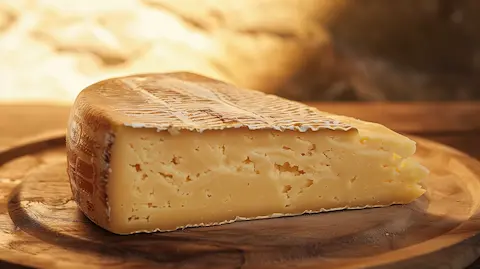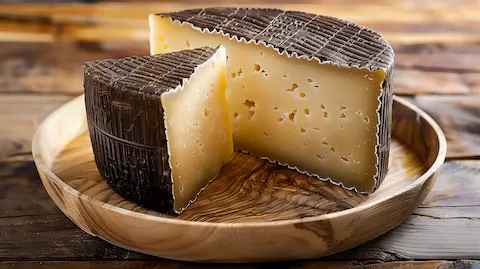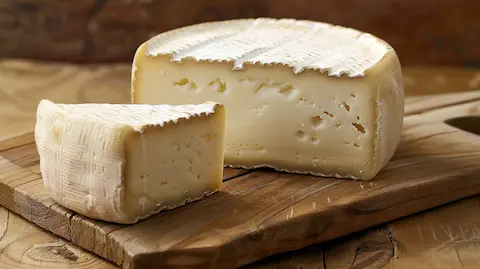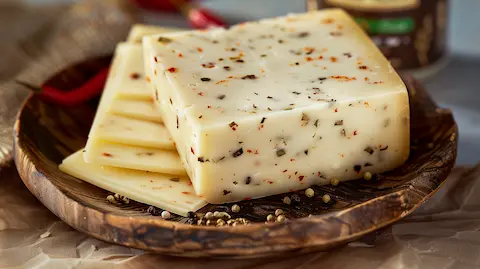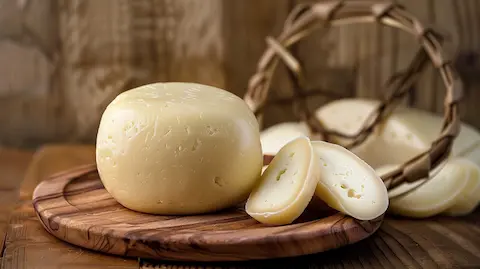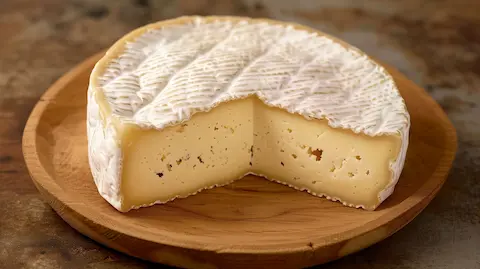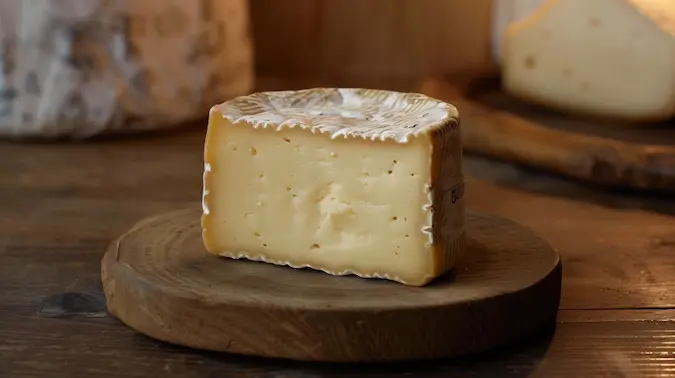Miss Muffet Cheese
Miss Muffet is a Cornish cheese, crafted with care from pasteurized cow's milk at Whalesborough Farm Foods near Bude in North Cornwall, England. This semi-soft, artisan cheese boasts a smooth, supple texture, an ivory hue, and is encased in a washed rind. Its creamy flavor and nutty aroma have earned it accolades, likening it to the finest Dutch Edams and Goudas, and it has garnered prestigious awards, making it a favorite among vegetarians and cheese aficionados alike.
Explore the creation process of this award-winning cheese in the following section.
How is Miss Muffet made?
Miss Muffet cheese is made by following a meticulous process that begins with the collection of high-quality pasteurized cow's milk. The milk is gently heated and then combined with cultures and rennet to initiate the curdling process. Once the curd has formed, it is carefully cut, allowing the whey to separate. The curds are then pressed into molds, giving Miss Muffet its distinctive shape. After being removed from the molds, the cheese is bathed in a brine solution to develop its rind and enhance its flavor profile. The final step involves aging the cheese in carefully controlled conditions to achieve its signature creamy texture and nutty aroma.
For a closer look at the production process, refer to the table below.
Miss Muffet Production Process
| Step | Ingredient | Method | Temperature | Duration |
|---|---|---|---|---|
| Milk Collection | Pasteurized cow's milk | Gathering and quality inspection | Room temperature | Varies |
| Heating | Cow's milk | Gentle pasteurization | 72°C (161°F) | 15 seconds |
| Culturing | Starter cultures | Inoculation of milk | 32°C (90°F) | 1 hour |
| Rennet Addition | Rennet | Coagulation of milk | 32°C (90°F) | 30 minutes |
| Curd Cutting | Separation of curds and whey | 32°C (90°F) | Varies | |
| Pressing | Forming the cheese | Room temperature | 2-4 hours | |
| Brining | Brine solution | Salt bath for rind development | 10-14°C (50-57°F) | 24 hours |
| Aging | Maturation of cheese | 13-15°C (55-59°F) | 2-3 months |
What does Miss Muffet taste like
Miss Muffet tastes like a harmonious blend of creamy and nutty notes, reminiscent of the finest Dutch Edams and Goudas. This cheese's smooth, supple texture complements its mild yet distinctive flavor profile, making it a versatile addition to any cheese board or recipe.
Miss Muffet Cheese Profile
With a rich heritage rooted in the lush pastures of North Cornwall, Miss Muffet cheese presents a profile that is as delightful to the palate as it is to the eye. This section unfolds the characteristics that make Miss Muffet a standout in the world of cheeses.
- Made from: Pasteurized cow's milk
- Country of origin: England
- Region: North Cornwall
- Family: Semi-soft, artisan
- Type: Washed rind cheese
- Texture: Smooth and supple
- Rind: Washed
- Colour: Ivory
- Flavour: Creamy with nutty notes
- Aroma: Nutty
- Vegetarian: Yes
- Producers: Whalesborough Farm Foods
- Safe for dogs: Cheese is not recommended for dogs
- PDO status: Not applicable
Origin: Where does Miss Muffet cheese come from?
Miss Muffet cheese originates from Whalesborough Farm Foods, located near Bude in the serene region of North Cornwall, England. This locale provides the ideal conditions for producing the high-quality pasteurized cow's milk that forms the basis of this exquisite cheese.
How is Miss Muffet made?
Miss Muffet cheese is made by following a meticulous process that begins with the collection of high-quality pasteurized cow's milk. The milk is gently heated and then combined with cultures and rennet to initiate the curdling process. Once the curd has formed, it is carefully cut, allowing the whey to separate. The curds are then pressed into molds, giving Miss Muffet its distinctive shape. After being removed from the molds, the cheese is bathed in a brine solution to develop its rind and enhance its flavor profile. The final step involves aging the cheese in carefully controlled conditions to achieve its signature creamy texture and nutty aroma.
For a closer look at the production process, refer to the table below.
Miss Muffet Production Process
| Step | Ingredient | Method | Temperature | Duration |
|---|---|---|---|---|
| Milk Collection | Pasteurized cow's milk | Gathering and quality inspection | Room temperature | Varies |
| Heating | Cow's milk | Gentle pasteurization | 72°C (161°F) | 15 seconds |
| Culturing | Starter cultures | Inoculation of milk | 32°C (90°F) | 1 hour |
| Rennet Addition | Rennet | Coagulation of milk | 32°C (90°F) | 30 minutes |
| Curd Cutting | Separation of curds and whey | 32°C (90°F) | Varies | |
| Pressing | Forming the cheese | Room temperature | 2-4 hours | |
| Brining | Brine solution | Salt bath for rind development | 10-14°C (50-57°F) | 24 hours |
| Aging | Maturation of cheese | 13-15°C (55-59°F) | 2-3 months |
How to store Miss Muffet?
Proper storage of Miss Muffet cheese ensures its quality and longevity. To maintain its creamy texture and nutty flavor, store Miss Muffet in the refrigerator, wrapped in parchment paper followed by a loose layer of plastic wrap. This allows the cheese to breathe while retaining moisture. Avoid storing it in the coldest part of the fridge to prevent it from drying out.
- Refrigerate: Keep below 4°C (39°F) in the cheese drawer or a warmer part of the fridge.
- Wrap: First in parchment paper, then loosely in plastic wrap.
- Store: In a cheese container or a designated cheese drawer.
- Check: Regularly inspect for any signs of spoilage or mold.
- Consume: Best enjoyed within the time frame for optimal taste and texture.
How long does Miss Muffet cheese last?
miss muffet cheese has a varied shelf life depending on storage conditions. When kept in the fridge, it can last for several weeks if stored correctly. Freezing is not recommended as it can alter the texture and taste of the cheese. If frozen and then thawed, the cheese may become crumbly and lose some of its creamy texture and flavor nuances.
| Storage Location | Shelf Life | Texture After Thawing | Taste After Thawing |
|---|---|---|---|
| Outside | 2 hours | ||
| Fridge | 3-4 weeks | N/A | N/A |
| Freezer | Not recommended | Crumbly | Muted |
Is Miss Muffet cheese pasteurized?
Yes, Miss Muffet cheese is made from high-quality pasteurized cow's milk. Pasteurization is a process that eliminates harmful bacteria while preserving the milk's natural flavor, which is essential in crafting the creamy and nutty characteristics of Miss Muffet cheese.
Can you freeze Miss Muffet?
No, freezing Miss Muffet cheese is not advisable. While it is technically possible to freeze cheese, doing so can significantly alter its texture and taste. Miss Muffet's creamy and supple texture may become crumbly, and its nuanced flavors might be muted after thawing. For the best sensory experience, enjoy Miss Muffet cheese fresh and store it in the refrigerator as recommended.
How do you know if Miss Muffet cheese has gone bad?
To determine if Miss Muffet cheese has spoiled, look for signs of mold, an off-putting smell, or any changes in texture. Eating moldy Miss Muffet cheese could lead to foodborne illness, especially for individuals with weakened immune systems. If you spot mold or detect any spoilage indicators, discard the cheese to ensure safety.
Alternatives to Miss Muffet Cheese
While Miss Muffet is unique in its own right, there are several other cheeses that can serve as suitable alternatives. Whether you're looking for a similar flavor profile or need a substitute due to availability, the following table outlines some excellent options.
Miss Muffet Substitutes
| Cheese | Origin | Texture | Flavor | Best Used In |
|---|---|---|---|---|
| Edam | Netherlands | Semi-soft | Mild, nutty | Sandwiches, salads |
| Gouda | Netherlands | Semi-soft to hard | Creamy, buttery | Grilled cheese, soups |
| Havarti | Denmark | Semi-soft | Buttery, slightly sweet | Melting dishes, sandwiches |
| Fontina | Italy | Semi-soft | Mild, slightly tangy | Fondue, pizza |
| Maasdam | Netherlands | Semi-soft | Sweet, nutty | Snacking, cheese boards |
Miss Muffet Popular Comparison
When considering a popular comparison, Edam often comes to mind due to its similar nutty flavor and semi-soft texture.
Comparative Cheese Profile
| Cheese | Origin | Milk Source | Texture | Flavor | Aging Time | Uses |
|---|---|---|---|---|---|---|
| Miss Muffet | England | Cow's milk | Semi-soft, supple | Creamy, nutty | 2-3 months | Cheese boards, cooking |
| Edam | Netherlands | Cow's milk | Semi-soft | Mild, nutty | 1-4 months | Sandwiches, snacks |
WhatCheese invites you to explore the nutritional aspects of Miss Muffet in the next section.
How to use Miss Muffet
Miss Muffet excels in both cooked and raw applications. Its creamy texture melts beautifully, making it an ideal candidate for grilled sandwiches, sauces, and fondues. When served raw, it adds a nutty, creamy element to salads and cheese boards. For optimal enjoyment, bring the cheese to room temperature before serving to enhance its natural flavors.
| Usage | Description |
|---|---|
| Melting | Perfect for grilled cheese sandwiches and fondues. |
| Cooking | Adds creaminess to sauces and baked dishes. |
| Raw | Enhances salads and cheese boards with its nutty profile. |
| Slicing | Use a wire cheese cutter or thin-bladed knife for clean cuts. |
How to serve Miss Muffet cheese
Serve Miss Muffet on a platter with fruits, nuts, and a selection of bread or crackers to complement its creamy and nutty character. Pair with a medium-bodied white wine or a light red to elevate the tasting experience.
Next, we will explore the nutritional data of Miss Muffet, providing valuable insights for those mindful of their dietary choices.
Recipes using Miss Muffet
Miss Muffet's creamy and nutty profile makes it a superb choice for various culinary creations. Its ability to melt seamlessly into dishes enhances flavors and adds a luxurious texture.
- Grilled Cheese Sandwich: Miss Muffet's meltability transforms a simple sandwich into a gourmet experience.
- Vegetable Quiche: The cheese's smooth texture complements the egg base and adds depth to the vegetables.
- Cheesy Pasta Bake: When baked, Miss Muffet creates a golden, savory crust that's irresistible.
- Stuffed Mushrooms: Its creamy nature makes it an ideal filling, pairing well with the earthy tones of the mushrooms.
- Apple and Cheese Tart: The nutty notes of Miss Muffet contrast beautifully with the sweetness of apples.
Explore Miss Muffet's nutritional data in the following section to understand its role in a balanced diet.
Miss Muffet Nutrition Data
There are 356 calories in Miss Muffet cheese per 100g. This cheese also provides a source of protein and calcium, making it a nutritious addition to various dishes.
| Nutrient | Amount per 100g | % Daily Value* |
|---|---|---|
| Calories | 356 | 18% |
| Total Fat | 27.8g | 43% |
| Saturated Fat | 17.8g | 89% |
| Cholesterol | 100mg | 33% |
| Sodium | 621mg | 26% |
| Total Carbohydrates | 3.1g | 1% |
| Dietary Fiber | 0g | 0% |
| Sugars | 0.1g | N/A |
| Protein | 23.7g | 47% |
| Calcium | 700mg | 70% |
| Iron | 0.2mg | 1% |
Alternatives to Miss Muffet Cheese
While Miss Muffet is unique in its own right, there are several other cheeses that can serve as suitable alternatives. Whether you're looking for a similar flavor profile or need a substitute due to availability, the following table outlines some excellent options.
Miss Muffet Substitutes
| Cheese | Origin | Texture | Flavor | Best Used In |
|---|---|---|---|---|
| Edam | Netherlands | Semi-soft | Mild, nutty | Sandwiches, salads |
| Gouda | Netherlands | Semi-soft to hard | Creamy, buttery | Grilled cheese, soups |
| Havarti | Denmark | Semi-soft | Buttery, slightly sweet | Melting dishes, sandwiches |
| Fontina | Italy | Semi-soft | Mild, slightly tangy | Fondue, pizza |
| Maasdam | Netherlands | Semi-soft | Sweet, nutty | Snacking, cheese boards |
What's next? WhatCheese insights
As the founder of WhatCheese, I take great pleasure in sharing insights on the delightful Miss Muffet cheese. For enthusiasts eager to acquire this Cornish gem, it is available at select specialty cheese shops and can also be ordered directly from Whalesborough Farm Foods. The farm itself has become a destination for cheese lovers, offering an authentic experience that showcases the artisanal methods behind Miss Muffet's creation. Moreover, renowned vineyards in the area often feature cheese tastings where Miss Muffet is paired with fine wines, accentuating its creamy and nutty flavor profile.
For those looking to immerse themselves in the world of cheese, there are annual events that celebrate artisan cheese-making, including Miss Muffet. These events provide an opportunity to meet cheesemongers, sample a variety of cheeses, and gain deeper knowledge about cheese pairing and selection. I encourage enthusiasts to attend these gatherings to fully appreciate the craft and community behind cheeses like Miss Muffet.
If you appreciate the semi-soft, creamy delights of Miss Muffet, other cheeses in the same firmness category include Havarti, known for its buttery and slightly sweet taste, and fontina, with its mild and slightly tangy flavor. Both are excellent choices for those seeking to expand their cheese horizons.




